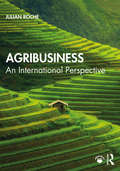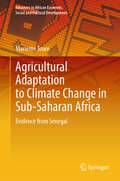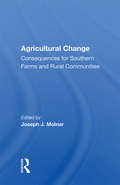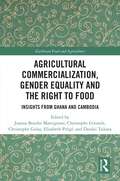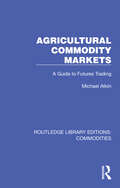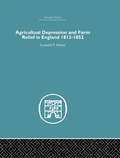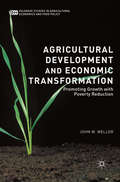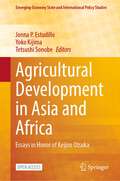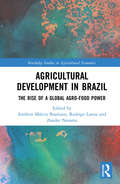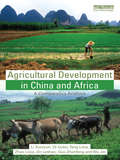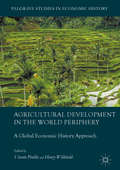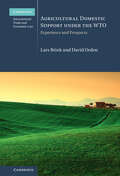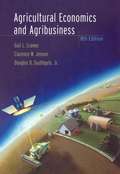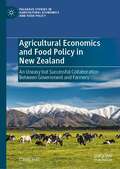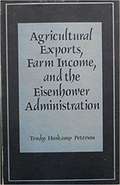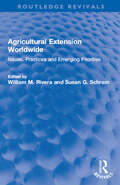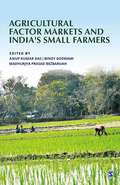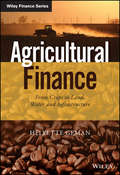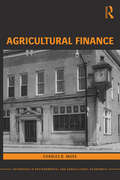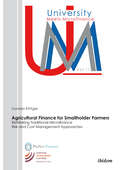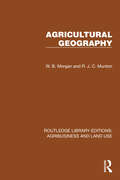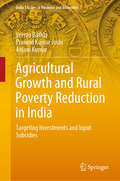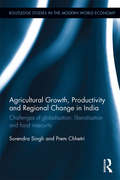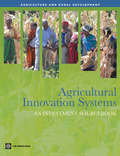- Table View
- List View
Agribusiness: An International Perspective
by Julian RocheAgribusiness offers a unique introduction to the business of agriculture: what agribusiness is, why it matters, what the role of technology is, how trade fits into the picture, what its key risks are, who is lending and investing and why, and what returns they are getting. It is both practical in orientation – focusing on the role of managers in the industry as well as that of lenders and investors – and international in scope – drawing on case studies and interviews with key figures all over the world. The text ranges across various agricultural commodities to stress that there is no ‘one size fits all’ solution and successful management, lending or investment in agribusiness requires understanding specifics. Readers are introduced to the economics of the supply and demand of food, the role of agricultural trade, agricultural marketing and farm management along with key business aspects including: Main drivers of agribusiness value; Principal risks of agribusinesses; Agribusiness as an investment class; and Agribusiness lending: why, who and how. This engaging textbook offers a complete guide to the international business of agriculture which is ideal for all students, scholars and practitioners. A selection of eResources is also available to supplement this text, and instructors will find PowerPoint slides, discussion questions, case studies and further teaching materials available to them.
Agricultural Adaptation to Climate Change in Sub-Saharan Africa: Evidence from Senegal (Advances in African Economic, Social and Political Development)
by Marieme ToureIn the light of the impact of extreme weather events, declining agricultural productivity and child malnutrition in sub-Saharan Africa, this book explores the potential for sustainable agriculture to better respond to climate-related threats. By presenting a case study of Senegal, the author offers insights into the impact of climate change on long-term crop production, food security, and child malnutrition. Furthermore, the study sheds new light on the financialization of agricultural production and foreign direct investments, discusses policy instruments and adaptation strategies for implementing sustainable agriculture, and highlights the role of green financing instruments to enable the harmonization of private financing and green infrastructure. It will appeal to scholars of agricultural and development economics, and anyone interested in climate risk mitigation strategies and sustainable agriculture to achieve a green transition in sub-Saharan Africa.
Agricultural Change: Consequences For Southern Farms And Rural Communities
by Joseph J. MolnarThis book examines the impact of the rise and fall of new commodities, production technologies, and shifting government policies on individuals and farm families in the rural South and the interrelationship between agricultural change and community change.
Agricultural Commercialization, Gender Equality and the Right to Food: Insights from Ghana and Cambodia (Earthscan Food and Agriculture)
by Christophe Golay Elisabeth Prügl Joanna Bourke Martignoni Christophe Gironde Dzodzi TsikataThis volume explores agricultural commercialization from a gender equality and right to food perspective. Agricultural commercialization, involving not only the shift to selling crops and buying inputs but also the commodification of land and labour, has always been controversial. Strategies for commercialization have often reinforced and exacerbated inequalities, been blind to gender differences and given rise to violations of the human rights to food, land, work and social security. While there is a body of evidence to trace these developments globally, impacts vary considerably in local contexts. This book systematically considers these dynamics in two countries, Cambodia and Ghana. Profoundly different in terms of their history and location, they provide the basis for fruitful comparisons because they both transitioned to democracy in the early 1990s, made agricultural development a priority, and adopted orthodox policies of commercialization to develop the sector. Chapters illustrate how commercialization processes are gendered, highlighting distinctive gender, ethnic and class dynamics in rural Ghana and Cambodia and the different outcomes these generate. They also show the ways in which food cultures are changing and the often-problematic impact of these changes on the safety and quality of food. Specific policies and legal norms are examined, with chapters addressing the development and implementation of frameworks on the right to food and land administration. Overall, the volume brings into relief multiple dimensions shaping the outcomes of processes of commercialization, including gender orders, food cultures, policy translation, national and sub-national policies, corporate investments and programmes, and formal and informal legal norms. In doing so, it offers insight not only on our case countries, but also provides proposals to advance rights-based research on food security. This book will be of great interest to students and scholars of food security, agricultural development and economics, gender, human rights and sustainable development.
Agricultural Commodity Markets: A Guide to Futures Trading (Routledge Library Editions: Commodities #2)
by Michael AtkinOriginally published in 1989, this book is a clear and thorough guide to the workings and purpose of the futures markets. It begins by explaining the role of futures and options in agriculture and their uses in reducing risks and maximizing profits. The state of the futures industry in the USA, Europe, Japan and the smaller exchanges elsewhere during the 1980s is examined, the pattern of price movements analysed, and the major background factors which influence price movements discussed. The regulatory environment in the US and UK is analysed, and there is a thorough explanation of fundamental and technical approaches to price forecasting and of strategies to maximize profits from trading. Detailed profiles of the major agricultural commodities traded on futures markets comprise the second part of this comprehensive handbook. The major markets, price movements, and trading opportunities are outlined for each commodity in turn. The book concludes by discussing the contemporary issues facing futures trading, and the role of the markets in the agricultural trade of developing countries.
Agricultural Depression and Farm Relief in England 1813-1852
by Leonard P. AdamsThis book was first published in 1932.
Agricultural Development and Economic Transformation: Promoting Growth with Poverty Reduction (Palgrave Studies in Agricultural Economics and Food Policy)
by John W. MellorThis book examines the role of agriculture in the economic transformation of developing low- and middle-income countries and explores means for accelerating agricultural growth and poverty reduction. In this volume, Mellor measures by household class the employment impact of alternative agricultural growth rates and land tenure systems, and impact on cereal consumption and food security. The book provides detailed analysis of each element of agricultural modernization, emphasizing the central role of government in accelerated growth in private sector dominated agriculture. The book differs from the bulk of current conventional wisdom in its placement of the non-poor small commercial farmer at the center of growth, and explains how growth translates into poverty reduction. This new book is a follow up to Mellor's classic, prize-winning text, The Economics of Agricultural Development.
Agricultural Development in Asia and Africa: Essays in Honor of Keijiro Otsuka (Emerging-Economy State and International Policy Studies)
by Tetsushi Sonobe Jonna P. Estudillo Yoko KijimaThis Open Access book explores the multifaceted nature of agricultural and rural development in Asia and examines the extent to which the Asian experience is being replicated in contemporary Africa. This volume compiles the works of top scholars who provided analyses and evidences from household-level surveys collected for many years in several parts of Asia and Africa. The most important finding presented in this book is that African agricultural development has evolved following the pathways of Asian agricultural development. The common pathways are borrowed technology from abroad and adaptive research in rice farming; secured property rights on natural resources; adoption of ICTs; investments in human capital, including training; and launching of the high-value agriculture. In both continents, agricultural development started in the crop sector, which had a strong tendency to induce the dynamic development of other sectors in rural areas.
Agricultural Development in Brazil: The Rise of a Global Agro-food Power (Routledge Studies in Agricultural Economics)
by Antonio M. Buainain Rodrigo Lanna Zander NavarroIn the last few decades, Brazilian agriculture has experienced a seismic transformation, and its contradictory facets have fed different and opposing narratives regarding recent changes. This book covers these changes, exploring the issues from several empirical and analytical angles, including the role of agriculture in the contemporary Brazilian economy, the dynamics of Brazilian agricultural value chains, environmental challenges and the processes of social differentiation. Brazilian agriculture continues to be viewed in the international literature, either through the lenses of the past century – those of former problems relating to land use and land tenure – or apologetically. This collection of essays aims at updating the current interpretations, providing objective accounting of the main transformations, its determinants, results, contradictions and limitations. As it covers the most relevant traits of Brazilian agricultural and rural development, the book will provide the reader with an encompassing view of contemporary Brazilian agriculture, including the positive and negative sides of the so-called tropical agriculture revolution. It highlights the tremendous economic potential as well as the continuing structural heterogeneity, concentration of production and marginalization of millions of small farmers. Written in an engaging and accessible style, this book will be perfect for all those interested in learning about Brazilian agriculture. It will be of particular interest to undergraduate and graduate students of economic development, agricultural economics, rural sociology, comparative economic development, rural development and agricultural policies.
Agricultural Development in China and Africa: A Comparative Analysis
by Li Xiaoyun Qi Gubo Tang Lixia Zhao Lixia Jin Leshan Guo Zhanfeng Wu JinMany African countries are increasingly interested in learning from China's experiences in achieving effective agricultural development. The Chinese government and academic community are also keen to share experiences and lessons with Africa. China made agriculture one of its development assistance priorities at the Third FOCAC Summit in Beijing in 2006. This systematic comparative study of agricultural development in China and Africa provides a unique basis for African countries and international organizations seeking to understand agricultural development in China, and for China to understand agricultural development on the African continent. The book highlights experiences and lessons from China and, in particular, analyzes why Africa has not yet been able to emulate China's agricultural development trajectory. It compares the similarities and discrepancies in conditions, processes, and outcomes between China and Africa from the perspectives of investment, science and technology, policies and international development aid. Based on this it explores which experiences and lessons from China's agriculture development can be shared with African countries in order to contribute to the sustainable improvement and transformation of African agriculture. It does not claim that China has all of the answers, but while recognizing the diversity within both China and Africa, concludes that much can be gained from such a comparison.
Agricultural Development in the World Periphery: A Global Economic History Approach (Palgrave Studies in Economic History)
by Vicente Pinilla Henry WillebaldThis book brings together analysis on the conditions of agricultural sectors in countries and regions of the world’s peripheries, from a wide variety of international contributors. The contributors to this volume proffer an understanding of the processes of agricultural transformations and their interaction with the overall economies of Africa, Asia and Latin America. Looking at the nineteenth and twentieth centuries – the onset of modern economic growth – the book studies the relationship between agriculture and other economic sectors, exploring the use of resources (land, labour, capital) and the influence of institutional and technological factors in the long-run performance of agricultural activities. Pinilla and Willebald challenge the notion that agriculture played a negligible role in promoting economic development in the nineteenth and twentieth centuries, when the impulse towards industrialization in the developing world was more impactful.
Agricultural Domestic Support Under the WTO: Experience and Prospects (Cambridge International Trade and Economic Law)
by David Orden Lars BrinkThe WTO Agreement on Agriculture subjects different groups of developed and developing countries to different limits on domestic support and allows various exemptions from these limits. Offering a comprehensive assessment of the Agreement's rules and implementation, this book develops guidance toward socially desirable support policies. Although dispute settlement has clarified interpretation of the Agriculture and SCM Agreements, gaps remain between the legal disciplines and the economic effects of support. Considering the Agriculture Agreement also in the context of today's priorities of sustainability and climate change mitigation, Lars Brink and David Orden build a strategy that aligns the rules and members' commitments with the economic impacts of agricultural support measures. While providing in-depth analysis of the existing rules, their shortcomings and the limited scope of ongoing negotiations, the authors take a long-term view, where policies directed toward evolving priorities in agriculture are compatible with strengthened rules that reduce trade and production distortions.
Agricultural Economics And Agribusiness
by Gail L. Cramer Clarence W. Jensen Douglas D. SouthgateThis book examines the structure and organization of the agricultural industry, then discusses basic micro and macroeconomics principles as they apply to agriculture. Principles of economics are used to demonstrate to the reader that theory actually makes reality more understandable. The book is at the right level and is kept consistently up-to-date-the only text that has been consistently revised!
Agricultural Economics and Food Policy in New Zealand: An Uneasy but Successful Collaboration Between Government and Farmers (Palgrave Studies in Agricultural Economics and Food Policy)
by David HallThe book analyses agricultural economics and food policy in New Zealand, where farming produce has been by far the main export commodity. Farming exports’ importance, together with the need to diversify exports away from a former colonial relationship with the UK, makes liberalising agricultural trade a major concern for New Zealand. Farmers, themselves, have influenced, significantly, policy development and implementation through their organisation, Federated Farmers. After World War II farmers at first encouraged Government financial support for farming and by the 1980s farming was highly subsidised. Farmers recognised in the 1980s that New Zealand’s economic problems demanded reduced Government intervention and accepted ending farming subsidies. New Zealand then encouraged, globally, ‘farming without subsidies’. New Zealand projected an image of environmental cleanliness and greenness in support of its exporting but into the 21st century wrestled to maintain that image because farming impacted on water quality and climate change emissions.
Agricultural Exports, Farm Income, And The Eisenhower Administration
by Trudy PetersonAgriculture -- Economic aspects -- United States -- History.
Agricultural Extension Worldwide: Issues, Practices and Emerging Priorities (Routledge Revivals)
by William M. Rivera; Susan G. SchramFirst published in 1987, Agricultural Extension Worldwide presents an international perspective on agricultural extension and highlights extension as an integral function of agricultural development. Agricultural extension is one of the largest nonformal problem-solving educational systems in the world. It is generally concerned with transferring knowledge and research to farmers but may include services to other target audiences such as farm families and rural youth, as well as serve for developing rural community resources. In sixteen chapters, various major systems of extension are discussed along with factors that make for their success or failure, including the linkages required and the policy and financial supports necessary to make them effective. This book is a must read for scholars and researchers of agricultural economics, agricultural policy and agriculture in general.
Agricultural Factor Markets and India’s Small Farmers
by Anup Kumar Das Binoy Goswami Madhurjya Prasad BezbaruahIncompleteness and imperfections of the factor markets can inhibit farmers, particularly small farmers, from optimal utilization of resources, which limits the performance of the whole agriculture sector. In small farm agriculture, several important markets handling allocation of vital inputs and services have been emerging. Emerging markets such as the rental markets of farm machinery and equipment have received little attention in literature. Agricultural Factor Markets and India’s Small Farmers argues that the market efficacy for such critical services requires close examination. The decline of public sector provided extension service in the post Green Revolution period and the entry of private providers makes this especially important. Further, thinness of markets for farm credit, insurance and marketing services deserves incisive analysis, as small farms are often constrained by insufficiency of access to such services. The book analyses different factor markets to explore their interconnectedness and presents a comprehensive study on the factor market system.
Agricultural Finance
by Helyette GemanA comprehensive resource for understanding the complexities of agricultural financeAgricultural Finance: From Crops to Land, Water, and Infrastructure is a pioneering book that offers a comprehensive resource for understanding the worldwide agriculture markets, from spikes in agricultural commodity prices to trading strategies, and the agribusiness industry generally to the challenges of feeding the planet in particular. The book also goes in-depth on the topics of land, water, fertilizers, biofuels, and ethanol. Written by Helyette Geman--an industry expert in commodity derivatives--this book explores the agricultural marketplace and the cycles in agricultural commodity prices that can be the key to investor success.This resource addresses a wide range of other important topics as well, including agricultural insurance, energy, shipping and bunker prices, sustainability, investments in land, subsidies, agricultural derivatives, and farming risk-management. Other topics covered include structured products and agricultural commodities ETFs; trade finance in an era of credit shortage; securitization and commodity-linked notes; grains: wheat, corn, soybeans; softs: coffee, cocoa, cotton; shipping as a key component of agricultural trade; and the major agricultural shipping routes and the costs. The book:Offers the first comprehensive resource that deals with the all aspects of agricultural financeIncludes information that is crucial for pension funds, asset managers, hedge funds, agribusiness corporates, CTAs and regulatorsCovers a range of topics from agricultural bunker prices, futures, options to major shipping routes and the costsThis text is a must-have resource for accessing the information required to trade successfully in the agricultural marketplace.
Agricultural Finance (Routledge Textbooks in Environmental and Agricultural Economics)
by Charles B. MossThis textbook integrates financial economics and management in the area of agricultural finance. The presentation of financial economics discusses how the credit needs of farmer/borrowers are met by depositors through commercial banks. The financial management content presents methods used to make farm financial decisions including farm accounting, capital budgeting, and the analysis of risk. The textbook begins by developing the farm financial market focusing primarily on the market for debt. Next, the textbook presents an overview of accounting concepts important for the credit market. The accounting section provides a detailed discussion of the Farm Financial Standards Council’s suggestions for agricultural financial statements. Following the financial accounting, the book presents the use of ratio analysis applied to the farm firm. Next, the text describes capital budgeting followed by an introduction to risk analysis. Finally, the book presents the effect of debt decisions on the farm firm. In addition to the primary topics, the textbook includes a discussion of agricultural banking and monetary policy and an analysis of the choice of historical cost and market valued accounting methodologies on the farm debt decision.
Agricultural Finance for Smallholder Farmers: Rethinking Traditional Microfinance Risk and Cost Management Approaches (University Meets Microfinance #11)
by Daniela RöttgerEven though traditional microfinance has successfully paved the way for offering financial services to low-income populations without traditional collateral, many microfinance institutions (MFIs) are still reluctant to move into rural areas and agricultural finance, due to the perceived high risks and costs. Daniela Röttger's research demonstrates how MFIs can mitigate risks and costs of lending to smallholder farmers by using a combination of proven traditional microfinance mechanisms while adapting specific loan features and lending mechanisms to the particularities of smallholder agriculture. <P><P>She systematically compares traditional microfinance risk management mechanisms with agricultural microfinance approaches and identifies successful strategies. Eight MFIs providing agricultural finance to smallholder farmers in four countries in East and West Africa (Uganda, Kenya, Benin, Cameroon) were interviewed and their loan features and agricultural lending mechanism were analyzed. The study shows that MFIs can successfully serve smallholder farmers in rural areas. A strong commitment combined with sound in-house knowledge of agricultural value chains and the flexibility to adapt loan terms and lending procedures to the particularities of agriculture are needed to successfully develop and sustain agricultural microfinance.
Agricultural Fluctuations in Europe: From the Thirteenth to twentieth centuries
by Wilhelm AbelWilhelm Abel's study of economic fluctuations over a period of seven hundred years has long been established as a core text in European agricultural history. Professor Abel was one of the first economic historians to make extensive use of statistical data, and his scholarship and approach have had a decisive effect on the orientation of economic and agricultural history. Using data on population, wages and rents from England, France, Germany and the Low Countries, and, on occasion, from Italy, Scandinavia and Poland, here Professor Abel demonstrates the striking similarity in the overall economic development for all these areas. He also analyses, the short-term fluctuations that have affected agricultural development within this economic framework, and is able to show the broad significance of the shape of the late medieval depression, the scale of the desertions of villages that accompanies it, and the implications of the sixteenth century price revolution. The book's importance lies in tracing the long-term trends that have characterized European economic development since the High Middle Ages, and as such it has made an invaluable contribution to all comparative analyses of different Western European countries since it was first published in 1980.
Agricultural Geography (Routledge Library Editions: Agribusiness and Land Use #19)
by W. B. Morgan R. J. MuntonOriginally published in 1971, this book is a systematic study of the major features and factors of the location and distribution of global agricultural enterprises. Special emphasis is given to approaches to the subject developed by economists and economic geographers, but all aspects of agricultural geography are reviewed including physical environmental problems. An introduction to the problem of classification and data collection together with instruction in some simple analytical techniques is given to equip the student with the basic methods for their own research.
Agricultural Growth and Rural Poverty Reduction in India: Targeting Investments and Input Subsidies (India Studies in Business and Economics)
by Seema Bathla Pramod Kumar Joshi Anjani KumarThis book provides a blueprint for the allocation of public expenditures “in” and “for” agriculture at the dis-aggregated state level and suggests a reorientation in favour of disadvantaged regions where the marginal returns on additional investments would be higher. It provides insights into the inter-linkages between public expenditures, private investment, rural poverty, and agriculture productivity from a regional perspective to reflect upon spatial differences in the welfare effects of various investments, subsidies, and policies. The book focuses on agricultural growth and rural poverty reduction through public and private investments, non-farm employment, and other pathways to the formulation of appropriate policies at the dis-aggregated state level. It presents new evidence based on advanced econometric tools for analysing and understanding the relationship between public and private investments in agriculture and input subsidies (fertilizer, power, irrigation, and credit) together with their impacts at the dis-aggregated state level. The book also deliberates on an income based direct support system for farmers as an alternative to the existing input price subsidy regime. Accordingly, the book offers valuable insights not only for researchers working on poverty alleviation, rural economy, and agricultural growth, but also for policymakers.
Agricultural Growth, Productivity and Regional Change in India: Challenges of globalisation, liberalisation and food insecurity (Routledge Studies in the Modern World Economy)
by Surendra Singh Prem ChhetriAgriculture productivity, growth and regional change in post-colonial India from a spatial perspective are yet to be rigorously examined. In particular, the impacts of economic liberalisation, globalisation and deregulation are not being empirically investigated at a small-area level using advanced statistical and spatial techniques. Understanding the process of regional formation and the rapid transitioning of agricultural landscapes in the Post-Liberalisation phase is pivotal to developing and devising regional economic development strategies. This book employs advanced methods to empirically examine the key characteristics and patterns of regional change in agricultural growth and productivity. It offers insights on changes in agricultural production and practices since the colonial period through to the Post-Liberalisation phase in India. It also incorporates the key public policy debates on the progress of India’s agricultural development with the aim of formulating spatially integrated strategies to reduce rapid rise in the regional convergence and to promote equitable distribution of strategic government investment.
Agricultural Innovation Systems
by the editors at The World BankResearch, education, and extension investments, while usually necessary, are often insufficient alone to bring knowledge, technologies, and services that enable farmers and entrepreneurs to innovate. Efforts to strengthen research systems and increase the availability of knowledge have not increased innovation or the use of knowledge in agriculture at the pace or the scale required by the intensifying and proliferating challenges confronting agriculture. Agricultural Innovation Systems: An Investment Sourcebook contributes to the identification, design, and implementation of the investments, approaches, and complementary interventions most likely to strengthen agricultural innovation systems (AIS) and to promote innovation and equitable growth. The Sourcebook provides a menu of tools and operational guidance, as well as good practice lessons, to illustrate approaches to designing, investing in, and improving these systems. Managing the ability of agriculture to meet rising global demand and to respond to the changes and opportunities will require good policy, sustained investments, and innovation—not business as usual. Experience indicates that aside from a strong capacity in R&D, the ability to innovate is often related to collective action and coordination, exchange of knowledge among diverse actors, incentives and resources available to form partnerships and develop business, and an enabling environment. While consensus is developing about what is meant by 'innovation' and 'innovation system,' no detailed blueprint exists for making agricultural innovation happen at a given time, in a given place, for a given result. That said, the AIS approach, which looks at these multiple conditions and relationships that promote innovation in agriculture in specific contexts, has moved from a concept to a subdiscipline with principles of analysis and action. Drawing on approaches that have been tested at different scales in different settings, this Sourcebook emphasizes the lessons learned, benefits and impacts, implementation issues, and prospects for replicating or expanding successful practices. The Sourcebook reflects the experiences and evolving understanding of numerous individuals and organizations concerned with agricultural innovation, including the World Bank. It targets the key operational staff who design and implement lending projects in international and regional development agencies and national governments, as well as the practitioners who design thematic programs and technical assistance packages. The Sourcebook can also be an important resource for the research community and nongovernmental organizations.
